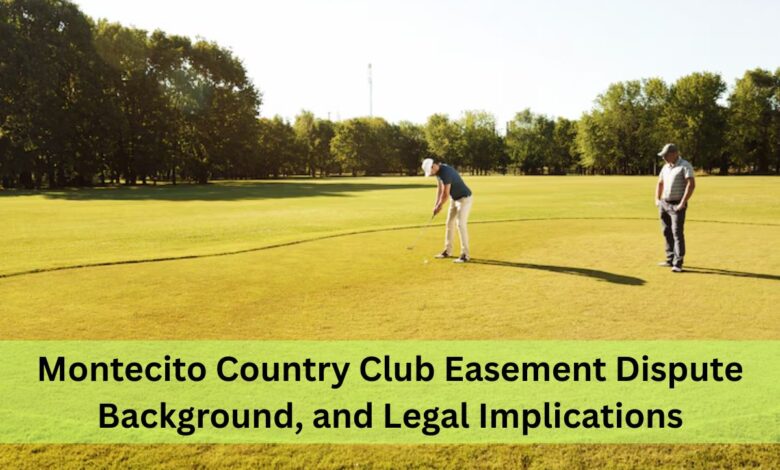Montecito Country Club Easement Dispute Background, and Legal Implications

Montecito, nestled in the peaceful Santa Barbara hills, is appreciated for its opulence, verdant scenery, and relaxed allure. But even in paradise, things don’t always go smoothly. A silent storm has been brewing recently, not in the skies, but among neighbors, legal teams, and one of Montecito’s most famous establishments, the Montecito Country Club easement dispute.
At the heart of this unfolding drama lies a centuries-old legal concept that most people never think about: easements. It’s a word that sounds simple, even boring. But when land access, property rights, and million-dollar views are on the line, the Montecito Country Club easement dispute can become the spark that lights a legal wildfire.
In this post, we’ll explore what’s going on behind the manicured lawns and sweeping fairways and why this easement dispute is more than just a legal issue. It reflects how even the most exclusive communities must grapple with boundaries, history, and a rapidly changing landscape.
The Background of the Montecito Country Club Easement Dispute
In July 2024, a legal battle culminated in a ruling by the Santa Barbara Superior Court involving the Montecito Country Club and neighboring property owners, Kevin and Jeannette Root.
The Roots had undertaken landscaping modifications on a section of land designated as an easement, which the Montecito Country Club legally owns. This issue became known as the Montecito Country Club Landscaping Easement Dispute, due to the unapproved changes made on a protected piece of land
These modifications included:
- Removal of an existing hedgerow.
- Installation of a new hedge along the property line.
- Regarding the easement area with imported soil.
- Construction of a retaining wall.
- Additional landscaping within the easement boundaries.
Notably, these changes were made without obtaining the necessary permissions from the club’s principal owner, Ty Warner, who holds exclusive authority over alterations to the easement area.
Legal Proceedings and Court Findings
The Montecito Country Club initiated legal action against the Roots, asserting that the unauthorized landscaping infringed upon their rights to utilize the easement for essential functions such as maintenance and potential future developments, including cart paths.
The case was heard by Judge Donna Geck, who issued the following important decision:
- The legal validity and enforceability of the disputed easement were confirmed.
- It was discovered that by making unapproved changes, the Roots had broken the terms of the easement.
A mandatory injunction was issued, requiring the Roots to:
- Remove all unauthorized landscaping features.
- Restore the easement area to its original condition at their own expense.
Community Reaction and Neighborhood Impact
The Montecito Country Club easement dispute has caused division in the formerly peaceful area. After years of relying on access via the club’s grounds, residents are either prohibited or subject to restrictions. Some homeowners contend that tradition and long-term use give them a claim, while others support the club’s right to defend its property.
In local forums and community meetings, emotions have been running hot. To join the action or defend their rights, some neighbors are even obtaining legal counsel. Many worry that the conflict could permanently undermine community relations because it has caused stress where there was previously harmony.
Broader Implications for Other Places
This conflict extends beyond the Montecito Country Club because it provides a useful example of how private clubs, locals, and towns strive to deal with the difficulties posed by shifting land usage.
Similar disagreements in contemporary societies may also be impacted by the ramifications. Particularly in high-value real estate markets where land ownership rights and aesthetics may conflict. Collaborative agreements, in which residents and clubs contribute to a committee to jointly manage the space, have been used in some communities to resolve some conflicts.
A similar agreement between the Montecito Country Club and the locals could serve as a model for other towns dealing with comparable issues.
Conclusion
Land-use conflicts often come down to perspective: some may see ‘progress,’ while others see ‘encroachment.’ The Montecito Country Club easement dispute reveals how modern land use, property law, and community relationships intersect.
Moving forward will require transparency and compromise, and good faith for a long-term solution. The club will have to strike a balance between modernizing and good community relations. Homeowners can feel secure knowing their rights are being appropriately upheld.
This is about the evolving connection between private institutions and the people around them. It goes far beyond a landscaping dispute.
If Montecito resolves this case, it may have an important effect on high-value property markets. The Montecito Country Club landscaping easement dispute may serve as a model for other upscale communities dealing with comparable legal disputes.
FAQ’s
Q: What is the Montecito Country Club Easement issue about?
The Montecito Country Club easement dispute concerns the use and legal rights of particular property easements. Regarding who has access to and uses these easements and under what conditions, the club and property owners cannot agree.
Q: Who is involved in the Montecito Country Club Easement Dispute?
The main parties involved in the Montecito Country Club easement dispute usually consist of representatives from the Montecito Country Club. They are neighboring homeowners, and occasionally, local city planning or legal authorities.
Read also: DecoratorAdvice com: Smart Decorating Starts Here




